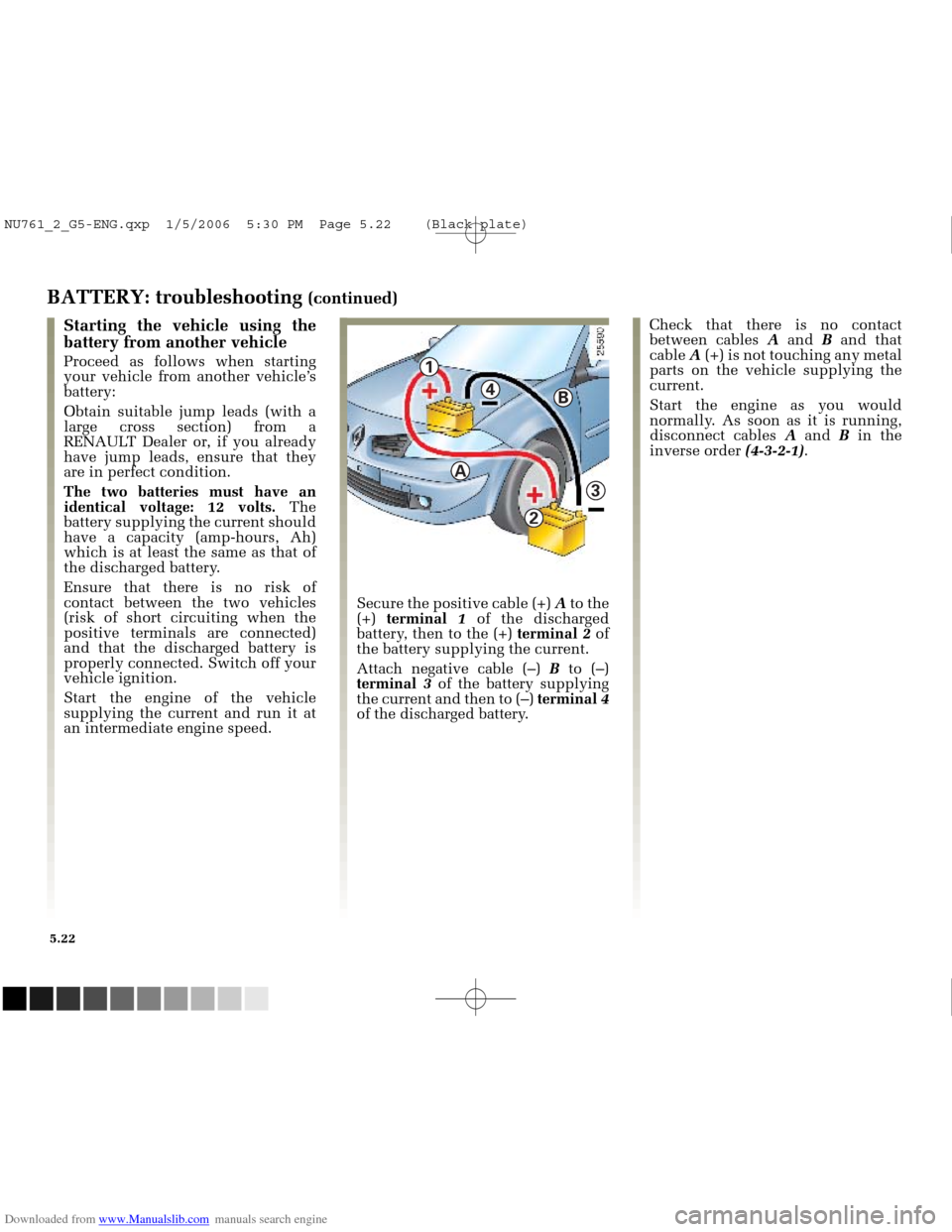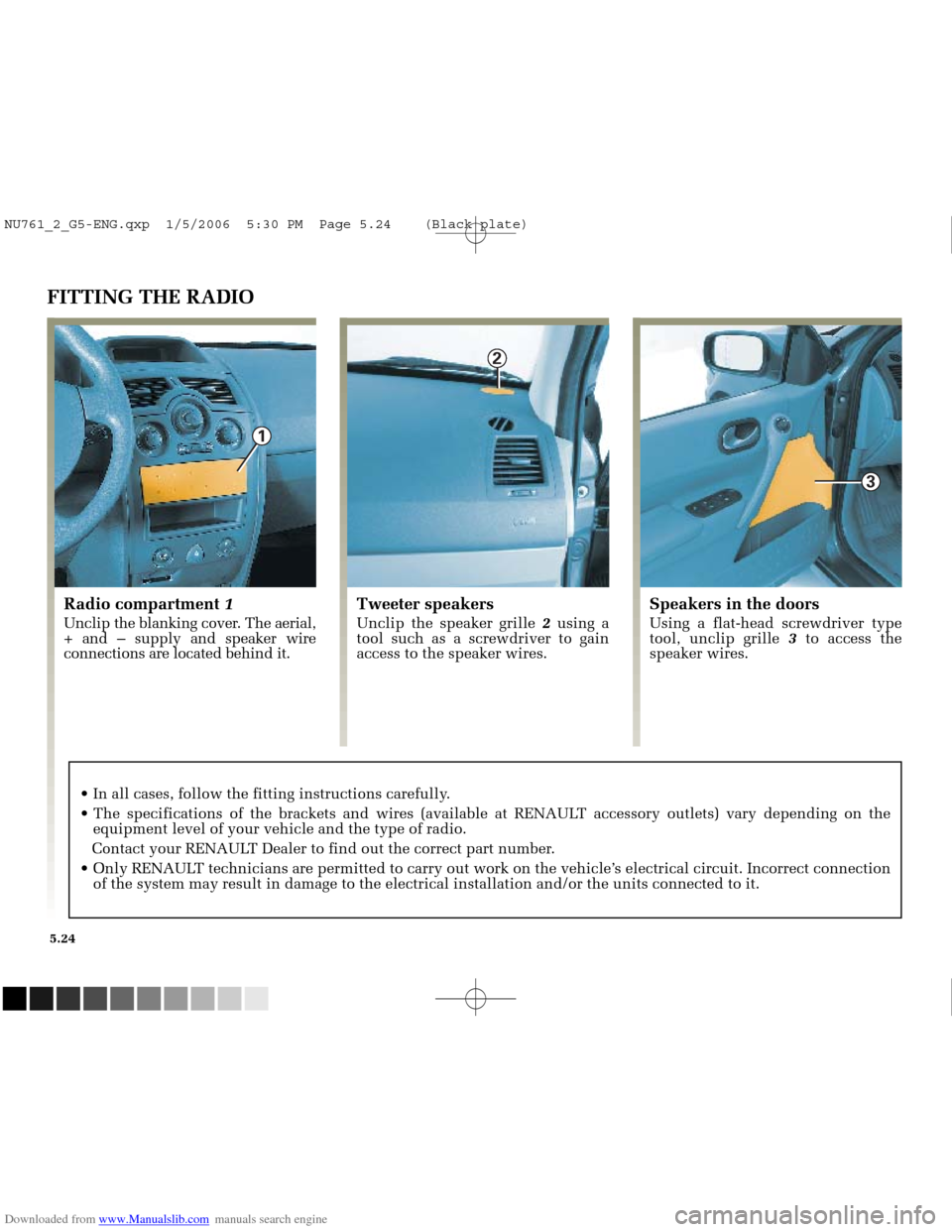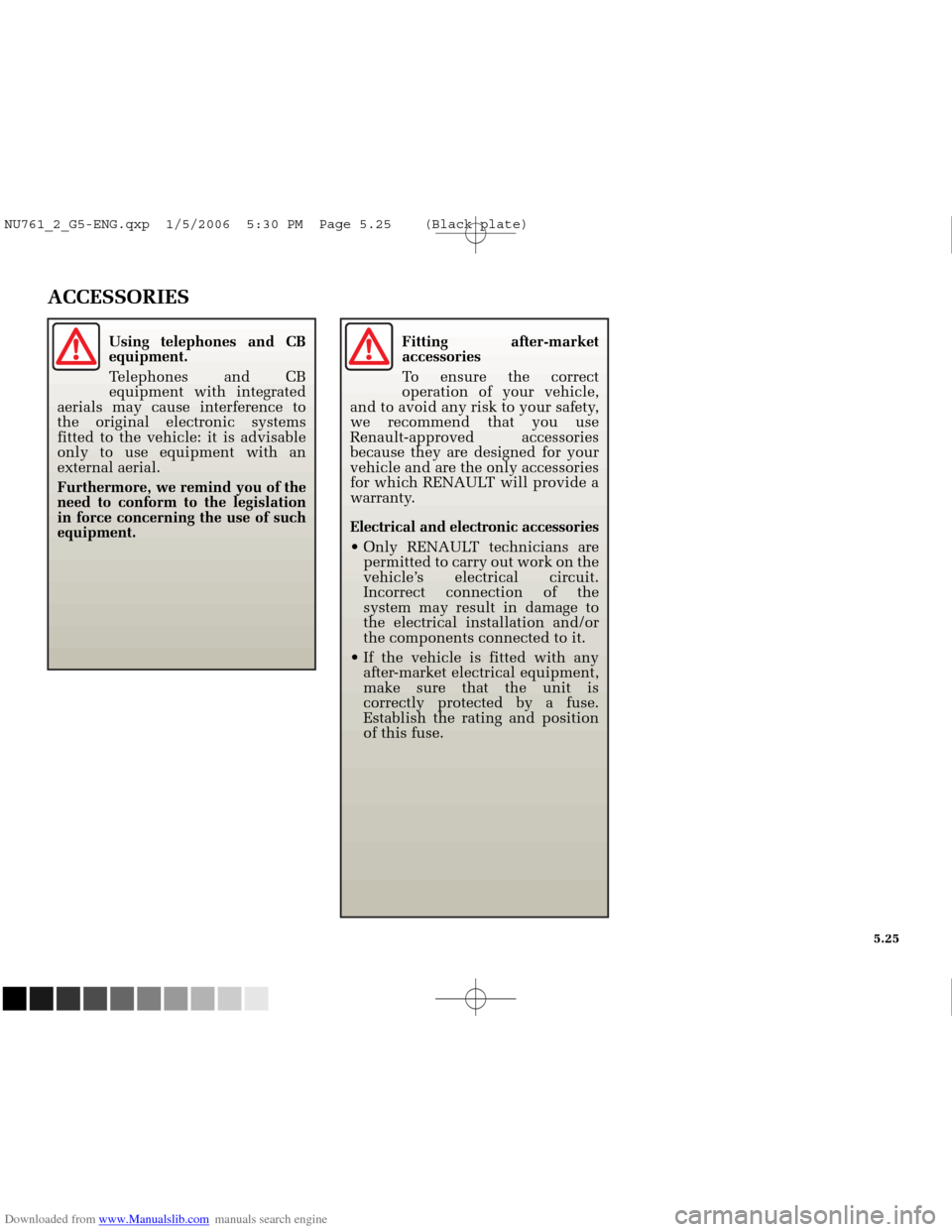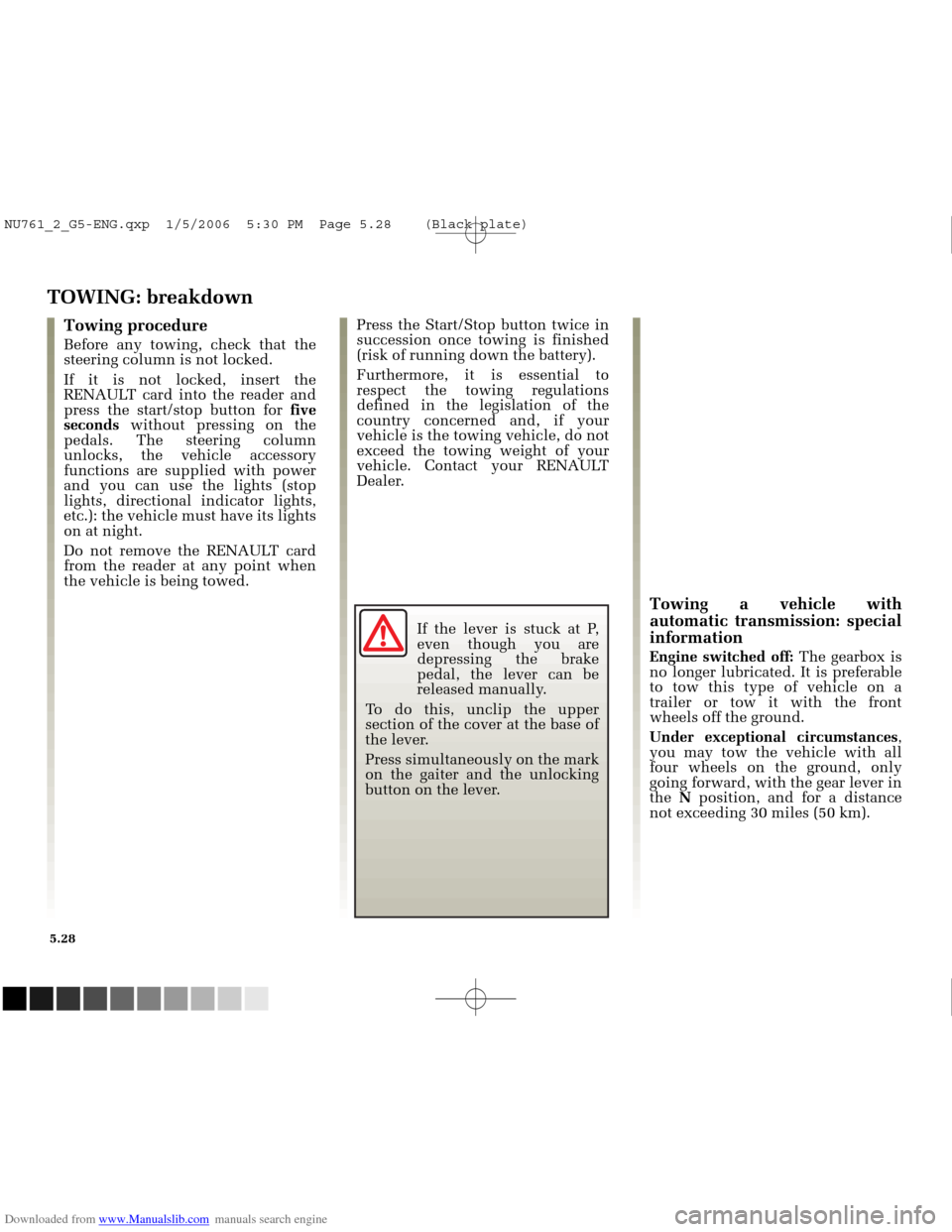Page 209 of 250

Downloaded from www.Manualslib.com manuals search engine
NU761_2_G5-FRA.qxd 4/11/05 11:09 Page 5.21
5.21
BATTERY: troubleshooting (continued)
Connecting a battery charger
The battery charger should be
compatible with a battery with a
nominal voltage of 12 Volts.
With the engine switched off, it is
essential to disconnect the cables
connected to both battery terminals,
starting with the negative terminal .
Do not disconnect the battery when
the engine is running. Follow the
manufacturer’s instructions for the
battery charger you are using.
Only a well-charged and well-
maintained battery will have a long
and useful life and enable you to
start the vehicle’s engine normally.
The battery must be kept clean and
dry.
Have the battery’s charge status
checked regularly:
Especially if you use your vehicle for short journeys or for frequent
driving in town. When the external temperature
drops (in winter), the charge
decreases . In winter, only use
electrical equipment which is
really necessary.
Finally, you should understand that the charge decreases naturally
as a result of certain “permanent
electrical consumers” such as the
clock, After-Sales accessories, etc.
When many accessories are fitted to
the vehicle, have them connected
to + after ignition feed . In this case,
it is advisable to have your vehicle
fitted with a battery which has an
increased capacity. Contact your
RENAULT Dealer. If your vehicle is to be left stationary
for a relatively long time, disconnect
the battery or have it recharged
regularly, in particular during cold
weather. The equipment with a
memory, radio etc. will then have to
be reprogrammed. The battery must
be stored in a cool dry place,
protected from frost.
Special procedures may
be required to charge
some batteries. Contact
your RENAULT Dealer.
Avoid all risk of sparks which
may cause an immediate
explosion and charge the battery
in a well-ventilated area. Risk of
serious injury.
NU761_2_G5-ENG.qxp 1/5/2006 5:30 PM Page 5.21 (Black plate)
Page 210 of 250

Downloaded from www.Manualslib.com manuals search engine
4
1
A
2
3
B
NU761_2_G5-FRA.qxd 4/11/05 11:09 Page 5.22
5.22
BATTERY: troubleshooting (continued)
Starting the vehicle using the
battery from another vehicle
Proceed as follows when starting
your vehicle from another vehicle’s
battery:
Obtain suitable jump leads (with a
large cross section) from a
RENAULT Dealer or, if you already
have jump leads, ensure that they
are in perfect condition.
The two batteries must have an
identical voltage: 12 volts. The
battery supplying the current should
have a capacity (amp-hours, Ah)
which is at least the same as that of
the discharged battery.
Ensure that there is no risk of
contact between the two vehicles
(risk of short circuiting when the
positive terminals are connected)
and that the discharged battery is
properly connected. Switch off your
vehicle ignition.
Start the engine of the vehicle
supplying the current and run it at
an intermediate engine speed. Check that there is no contact
between cables
Aand Band that
cable A(+) is not touching any metal
parts on the vehicle supplying the
current.
Start the engine as you would
normally. As soon as it is running,
disconnect cables A and B in the
inverse order (4-3-2-1).
Secure the positive cable (+) Ato the
(+) terminal 1 of the discharged
battery, then to the (+) terminal2 of
the battery supplying the current.
Attach negative cable (–) B to (–)
terminal 3 of the battery supplying
the current and then to (–) terminal4
of the discharged battery.
NU761_2_G5-ENG.qxp 1/5/2006 5:30 PM Page 5.22 (Black plate)
Page 211 of 250
Downloaded from www.Manualslib.com manuals search engine
24089
2
1
NU761_2_G5-FRA.qxd 4/11/05 11:09 Page 5.23
5.23
RENAULT CARD: BATTERY
Replacing the battery
The message “Change card battery”
appears on the instrument panel.
Pull firmly on emergency key 2.
Replace battery 1, observing the
polarity shown on the emergency key.
After the operation, the “Change
card battery” message no longer
appears on the instrument panel.
Batteries can be obtained from your
RENAULT Dealer.
These batteries should last about
two years.
Do not throw away your
used batteries, give them to
an organisation responsible
for collecting and recycling
batteries.
NU761_2_G5-ENG.qxp 1/5/2006 5:30 PM Page 5.23 (Black plate)
Page 212 of 250

Downloaded from www.Manualslib.com manuals search engine
3
2
1
NU761_2_G5-FRA.qxd 4/11/05 11:10 Page 5.24
5.24
FITTING THE RADIO
Tweeter speakers
Unclip the speaker grille 2using a
tool such as a screwdriver to gain
access to the speaker wires.
Speakers in the doors
Using a flat-head screwdriver type
tool, unclip grille 3to access the
speaker wires.
Radio compartment 1
Unclip the blanking cover. The aerial,
+ and – supply and speaker wire
connections are located behind it.
In all cases, follow the fitting instructions carefully.
The specifications of the brackets and wires (available at RENAULT accessory outlets) vary depending on theequipment level of your vehicle and the type of radio.
Contact your RENAULT Dealer to find out the correct part number.
Only RENAULT technicians are permitted to carry out work on the vehicle’s electrical circuit. Incorrect connection of the system may result in damage to the electrical installation and/or\
the units connected to it.
NU761_2_G5-ENG.qxp 1/5/2006 5:30 PM Page 5.24 (Black plate)
Page 213 of 250

Downloaded from www.Manualslib.com manuals search engine
NU761_2_G5-FRA.qxd 4/11/05 11:10 Page 5.25
5.25
ACCESSORIES
Using telephones and CB
equipment.
Telephones and CB
equipment with integrated
aerials may cause interference to
the original electronic systems
fitted to the vehicle: it is advisable
only to use equipment with an
external aerial.
Furthermore, we remind you of the
need to conform to the legislation
in force concerning the use of such
equipment. Fitting after-market
accessories
To ensure the correct
operation of your vehicle,
and to avoid any risk to your safety,
we recommend that you use
Renault-approved accessories
because they are designed for your
vehicle and are the only accessories
for which RENAULT will provide a
warranty.
Electrical and electronic accessories
Only RENAULT technicians are permitted to carry out work on the
vehicle’s electrical circuit.
Incorrect connection of the
system may result in damage to
the electrical installation and/or
the components connected to it.
If the vehicle is fitted with any after-market electrical equipment,
make sure that the unit is
correctly protected by a fuse.
Establish the rating and position
of this fuse.
NU761_2_G5-ENG.qxp 1/5/2006 5:30 PM Page 5.25 (Black plate)
Page 214 of 250
Downloaded from www.Manualslib.com manuals search engine
1
2
3
NU761_2_G5-FRA.qxd 4/11/05 11:10 Page 5.26
5.26
WINDSCREEN WIPER BLADES
Pull on tab 2.
Then, push the wiper blade
upwards.
To refit
To refit the wiper blade, proceed in
reverse order to removal. Make sure
that the blade is correctly locked in
position.
Clean your windscreen regularly.
Replacing windscreen wiper
blades 1
- With the ignition off , lift wiper
arm 3;
- turn the blade 1.
In frosty weather, makesure that the wiper
blades are not stuck by
ice (risk of motor
overheating).
Monitor the condition of the blades. Replace the wiper
blades as soon as they begin to
lose efficiency (approximately
once a year).
NU761_2_G5-ENG.qxp 1/5/2006 5:30 PM Page 5.26 (Black plate)
Page 215 of 250
Downloaded from www.Manualslib.com manuals search engine
5
6
NU761_2_G5-FRA.qxd 4/11/05 11:10 Page 5.27
5.27
WINDSCREEN WIPER BLADES (continued)
Regularly clean your rear screen.
Rear screen wiper blade 5
- Lift the wiper arm 6;
- move blade 5until some resistance
is met.
- remove the blade by pulling it. To refit
To refit the wiper blade, proceed in
reverse order to removal. Make sure
that the blade is correctly locked in
position.
In frosty weather, makesure that the wiper
blades are not stuck by
ice (to avoid the risk of
the wiper motor overheating).
Check the condition of the wiper blades.
Replace the wiper blades as
soon as they begin to lose
efficiency: approximately once
a year.
NU761_2_G5-ENG.qxp 1/5/2006 5:30 PM Page 5.27 (Black plate)
Page 216 of 250

Downloaded from www.Manualslib.com manuals search engine
NU761_2_G5-FRA.qxd 4/11/05 11:10 Page 5.28
5.28
TOWING: breakdown
Press the Start/Stop button twice in
succession once towing is finished
(risk of running down the battery).
Furthermore, it is essential to
respect the towing regulations
defined in the legislation of the
country concerned and, if your
vehicle is the towing vehicle, do not
exceed the towing weight of your
vehicle. Contact your RENAULT
Dealer.Towing procedure
Before any towing, check that the
steering column is not locked.
If it is not locked, insert the
RENAULT card into the reader and
press the start/stop button for five
seconds without pressing on the
pedals. The steering column
unlocks, the vehicle accessory
functions are supplied with power
and you can use the lights (stop
lights, directional indicator lights,
etc.): the vehicle must have its lights
on at night.
Do not remove the RENAULT card
from the reader at any point when
the vehicle is being towed.
Towing a vehicle with
automatic transmission: special
information
Engine switched off: The gearbox is
no longer lubricated. It is preferable
to tow this type of vehicle on a
trailer or tow it with the front
wheels off the ground.
Under exceptional circumstances ,
you may tow the vehicle with all
four wheels on the ground, only
going forward, with the gear lever in
the N position, and for a distance
not exceeding 30 miles (50 km).
If the lever is stuck at P,
even though you are
depressing the brake
pedal, the lever can be
released manually.
To do this, unclip the upper
section of the cover at the base of
the lever.
Press simultaneously on the mark
on the gaiter and the unlocking
button on the lever.
NU761_2_G5-ENG.qxp 1/5/2006 5:30 PM Page 5.28 (Black plate)